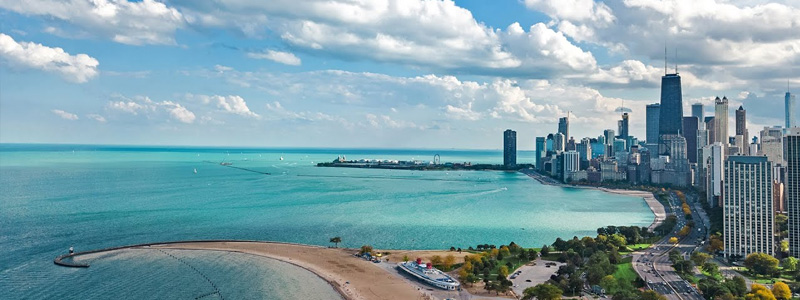Moving west to east by following Great Lakes websites, a virtual traveler can follow the water of the lakes as it journeys to the open sea – learning much along the way.
The five Great Lakes of North America beckon as a must-see attraction for most of the year, and a virtual trip around them can help travelers make their plans for the real thing.
The Great Lakes Information Network hosts a website for the Great Lakes Circle Tour that includes a page for each lake with a multitude of links leading to accommodations, campgrounds and parks, and local attractions. At the bottom of each page, you will find a link to more “Facts and Figures” for the particular lake.
Seeing the Upper Great Lakes: Superior and Michigan
Start this virtual trip in Lake Superior and move generally west to east, following the water of the Great Lakes on a journey that eventually leads it to the Atlantic Ocean. Tourists will need to make some hard choices about what to see and do around Lake Superior. The Canadian cities of Thunder Bay or Sault Ste. Marie, and within the U.S., Isle Royale National Park, the Apostle Islands in Wisconsin, and the Pictured Rocks National Seashore in Michigan are just some of the big reasons many love Lake Superior, the largest and deepest of the lakes.
If there’s time to visit only one website, scroll down on the Lake Superior page to “Parks and Recreation” and link to the Great Lakes Shipwreck Historical Society, which is located at Whitefish Point in the Upper Peninsula of Michigan. The museum is open in real-time every day from May 1 to October 31, and it provides a many-faceted introduction to Lake Superior’s fury, as well as its beauty.
The waters of Lake Superior flow, via the St. Mary’s River, into Lake Huron. From Lake Huron, some of the water flows back toward the west through the Straits of Mackinac and forms Lake Michigan. Hydrologically, Lakes Huron and Michigan are considered one lake, Lake Michigan is a cul-de-sac formation. The southern half of Lake Michigan will provide the visitor with a lot of summer-in-the-city excitement in Milwaukee and Chicago. The northern half of the lake’s watershed is heavily forested, and a tourism mecca.
For the virtual tour, on the Lake Michigan page, select Traverse City (the last one under “Cities and Towns”) for some gorgeous snapshots that are representative of the beauty that surrounds much of this lake.
From Lake Huron to Lake Erie
Under Lake Huron Facts and Figures the virtual tourist will find this succinct description: “The Lake Huron basin is heavily forested, sparsely populated, scenically beautiful, and economically dependent on its rich natural resources. ” Lake Huron has 30,000 islands and the two largest bays on the Great Lakes (Georgian and Saginaw Bays).
Virtually visit the Bruce Peninsula and the Georgian Bay Islands from the links under “Parks”.
Water leaves Lake Huron much faster than either Lake Michigan or Lake Superior. It flows south into the St. Clair River, then into small Lake St. Clair and out through the Detroit River before gathering in the western end of Lake Erie. This is the smallest and most shallow of the Great Lakes, which makes Lake Erie the warmest of the lakes, and the most biologically productive, according to Lake Erie Facts and Figures. Its walleye fishery is widely considered the best in the world.
While virtually visiting Lake Erie don’t miss this link under General Resources: Lake Erie Coastal Ohio. It leads to a rich online travel guide to natural, cultural, and historic attractions along Lake Erie’s Ohio coast.
Up Next: Niagara Falls, then Lake Ontario
Continuing the Great Lakes Circle Tour, the traveler will leave Lake Erie to the east following the Niagara River, and this is where things really get interesting!
The Niagara River is carrying the outflow from all four of the upper Great Lakes and it soon will plunge over a nearly 200-foot cliff of dolomite and shale, cascading over the width of the 2,600-foot-long wall of the Canadian Horseshoe Falls, and the 1,000 foot-long wall of the American Falls and the much smaller Bridal Veil Falls. At the bottom of the Falls, the Niagara River will travel another 15 miles through many gorges before reaching Lake Ontario – 325 feet lower than Lake Erie.
A virtual visit can be made to Niagara Falls, and then the final Great Lake on this virtual tour awaits. Lake Ontario is the smallest in surface area, but deep – it’s average depth being second only to Lake Superior. The eastern end of the lake where the water flows into the St. Lawrence River is known as the Thousand Islands region for the nearly two thousand small islands that fill the area, making it a natural magnet for boaters, campers, and picnickers.
Take a virtual tour of this area by choosing the link to Alexandria Bay under “Cities and Towns”. Then say good-bye to the Great Lakes, as the water from Lake Ontario flows down the St. Lawrence River to the sea. Or better yet, use all the information just accessed to plan your actual trip.

